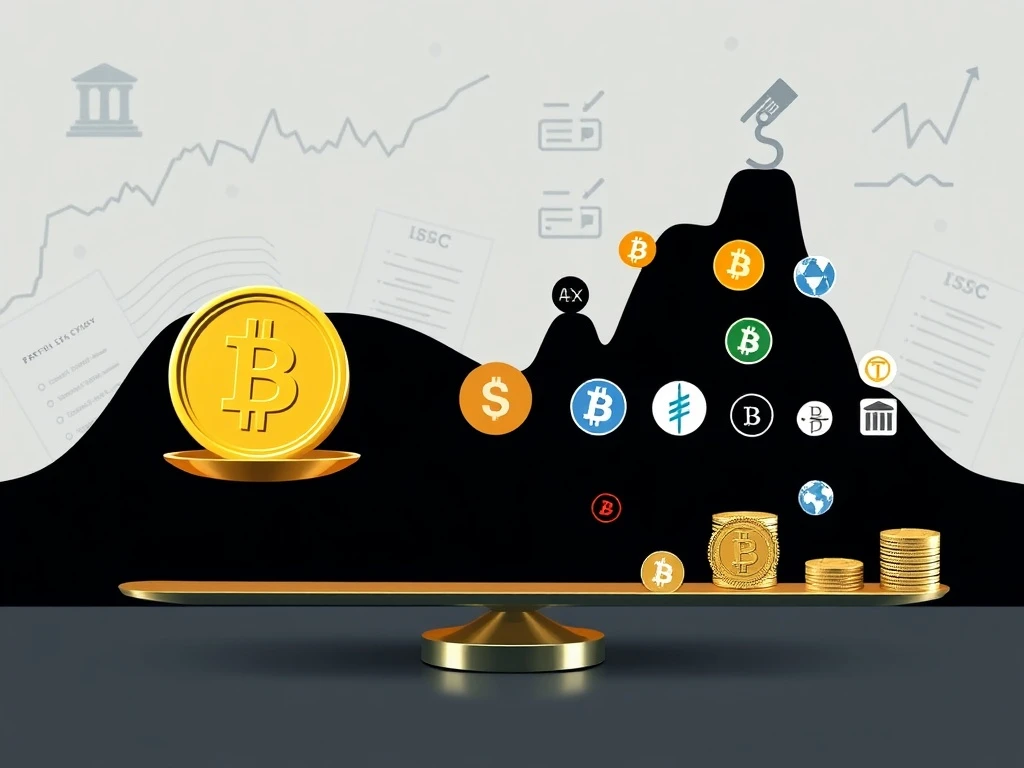Stablecoin Market: Transformative Shift as USDT, USDC Dominance Erodes to 84%

The cryptocurrency world often sees rapid change. Yet, the stablecoin market has long appeared dominated by two giants: Tether’s USDT and Circle’s USDC. However, this long-standing duopoly is now clearly eroding. Data shows their combined market share has significantly decreased, signaling a transformative shift. This evolution is reshaping how we view digital assets and their future. For investors and enthusiasts, understanding this change is critical.
The Evolving Stablecoin Market Landscape
For many years, Tether’s USDT and Circle’s USDC held significant power. These two stablecoins, by market capitalization, consistently led the sector. However, recent data confirms a notable shift. Their combined USDT USDC dominance has fallen to 84%. This marks a substantial change in the stablecoin market dynamics. Industry analyst Nic Carter recently highlighted this trend. He termed it “the stablecoin duopoly ending.” Carter points to a decline of over 5% since October 2024. Furthermore, it represents a 3.4% year-to-date drop. Their share peaked at 91.6% in March 2024. At that time, the total stablecoin market was worth around $140 billion. USDT had approximately $99 billion. USDC accounted for $29 billion. Now, their combined share sits lower. This indicates growing competition from new entrants. According to DefiLlama and CoinGecko, the combined market share fell further to 83.6% at the time of writing. This clearly shows a trend of diversification.
Why is the Stablecoin Duopoly Ending?
Several factors contribute to this decline. Carter identifies new assertiveness from intermediaries. Also, a “race to the bottom” with yield offerings plays a role. Finally, new crypto regulation dynamics post-GENIUS are impactful. New issuers can undercut major players. This applies especially to yield-bearing stablecoins. Banks also see an opportunity. They aim to bring big industry rivals into the space. This combination creates a dynamic environment. The market is becoming more diverse and competitive. Therefore, the landscape for digital currencies is undergoing a significant transformation.
The Rise of Yield-Bearing Stablecoins
The emergence of yield-bearing stablecoins is a key factor in this market shift. These assets offer passive income to holders, attracting significant capital. Ethena’s USDe stands out as a major success story of the year. It leverages crypto basis trades to provide yield. Its supply surged impressively to $14.7 billion. This makes it a significant player in the evolving ecosystem. Other notable names include Sky’s USDS and PayPal’s PYUSD. World Liberty’s USD1 is also gaining traction. Furthermore, analysts suggest watching Ondo’s USDY, Paxos’ USDG, and Agora’s AUSD. Many new stablecoins focus on these yield opportunities. This trend persists despite regulatory pressures. The US GENIUS Act introduced some scrutiny on yield-bearing products. Nevertheless, the drive for yield remains strong among users. New startups can offer competitive rates. This challenges established issuers like Circle. Circle, for example, explores yield options with Coinbase. This highlights the market’s evolving nature and the pursuit of investor value.
Bank Stablecoins and Shifting Crypto Regulation
Traditional financial institutions are increasingly entering the fray. Changes in crypto regulation enable banks to issue stablecoins. This marks a significant development for the broader financial system. Despite existing concerns about bank deposit runs, their entry seems inevitable. JPMorgan and Citigroup are already collaborating on stablecoin initiatives. Carter suggests bank consortia make the most sense for this endeavor. No single bank can achieve the necessary distribution. This is crucial for competing effectively with Tether. European banks also show growing interest. On September 25, Dutch lender ING announced a joint venture. This includes Italy’s UniCredit and seven more banks. They plan to build a potential euro-denominated stablecoin. This initiative complies with Europe’s Markets in Crypto-Assets Regulation (MiCA) framework. Its expected launch is in the second half of 2026. This demonstrates a growing institutional embrace. It also signifies a broader acceptance of digital currencies. These developments will undoubtedly reshape the stablecoin market profoundly.
Implications for USDT USDC Dominance and Future Outlook
The declining USDT USDC dominance signals a new era for digital assets. The market is becoming far more competitive and diverse. New players offer innovative features, particularly through yield-bearing stablecoins, which attract significant capital. Banks are bringing institutional weight and regulatory compliance to the table. This increased competition ultimately benefits users. It can lead to better products, enhanced services, and more choices. However, it also presents complex challenges. Regulatory frameworks must adapt quickly to these innovations. The landscape will continue to evolve rapidly. The “stablecoin duopoly” is indeed ending, as Nic Carter observed. A more diverse, dynamic, and regulated market is emerging. This trend promises exciting developments for the crypto ecosystem. Investors and market participants should monitor these changes closely. They will undoubtedly impact future investment strategies and the overall stability of the digital economy.








